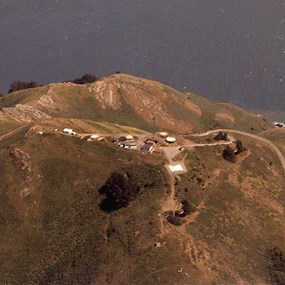Last updated: July 30, 2018
Article
Hawk Hill Restoration

NPS / Kirke Wrench
Although Hawk Hill is primarily known for migrating raptors, the wings of a much smaller creature known as the mission blue butterfly are what keeps restoration ecologists coming back to the site. One of the first invertebrates to be protected under the Endangered Species Act, this small butterfly is an important component of area grasslands. Though they are in the area year-round, they're most noticeable for only 6-8 weeks of the year when the adults can be seen flying about. Amazingly, these butterflies emerge from a 51-week hibernation and metamorphosis to travel to locate their food plants, mate, and die within a single week.
Mission blue numbers took a plummet in the mid-90s after a fungal pathogen attacked their host lupines. But in the last decade the park has undertaken a number of grassland restoration projects and butterflies appear to be rebounding in some places and spreading into other, recently restored areas.
Mission blues lay their eggs on three species of lupine that are the sole food source for their caterpillars. These lupines grow scattered among fields of coastal prairie and scrub, but because they thrive at recently disturbed sites, good lupine habitat is continuously shifting. Mission blue butterflies need to be able to follow this natural host plant movement, but they typically only travel 50 meters (164 feet) from the patch of lupine where they first emerged. Because they are such weak fliers, roads, trails, and dense stands of trees can pose enough of a barrier to prevent them from finding additional lupines, nectar plants, and mates.
Restoring Habitat for the Mission Blue
Over the past 30 years, non-native Monterey pine and cypress trees spread into the grasslands at Hawk Hill-likely arriving as hitchhikers in soil the military brought in to create their fortifications. The trees were so abundant and dense that they acted as a barrier between areas of lupine on either side of the ridgeline between the Rifle Range and Conzelman Road. In winter 2011-2012, the trees were removed, and native vegetation was planted to help the butterfly populations on either side of the ridge to merge into a more robust group, while also permitting them to follow natural shifts in lupines across the landscape. The Hawk Hill project also mitigates impacts from road and trail construction in the Marin Headlands Fort Baker Transportation Management Plan. Learn more about this project from the Golden Gate National Parks Conservancy's project information page.

Hawk Hill, or Battery Construction 129, has been a silent witness to the ecological and cultural changes in and around the San Francisco Bay for eons. It is the story of soldiers waiting for an enemy that never came. Although most of the World War II fortifications built in the park were intended to keep the newest battleships from reaching striking range, the war was fought and ultimately won from the air. Built into the highest point at the Golden Gate, Battery Construction 129 had two large guns mounted under thick concrete shields covered with native vegetation for camouflage and virtually invisible from above.
It features tunnels that connect the two gunpits, magazines, and storage rooms. After Pearl Harbor, the entire Western Defense Command was placed on high alert. Anti-aircraft guns were installed, and radar stations were developed. Even before the war ended, defending the San Francisco Bay against ships became superfluous, and heavy artillery soldiers were transferred to anti-aircraft duties.
During the Cold War, the Nike Defense system was put into place in the Bay Area and other urban areas throughout the U.S. Antiaircraft missiles were at ready from the Korean War all the way through the Strategic Arms Limitation Treaty of 1972. Guided by a complex system of radars and tracking computers, they had ranges of up to 87 miles and could shoot down planes traveling two to three times the speed of sound. The radar station buildings at Battery Construction129 have been removed. During the Cold War, the Nike Missile radar station required visual connection to the missile launching area at Fort Cronkhite (currently the Marine Mammal Center). Again, this technology was never used and a global nuclear missile crisis was averted.
Tree removal will also protect Battery Construction129 from damage caused by root growth, and future Hawk Hill improvements will focus on cultural resources and visitor amenities such as:
- Cultural Rehabilitation - Aging structures will be stabilized so that they can be explored and enjoyed.
- Preservation - Stabilizing the historic gun battery from World War II and the Nike Missile Radar features from the Cold War will preserve these important historic features and allow for greater public access and enjoyment.
- Recreation - The restored site will provide increased educational and volunteer opportunities. Improved gathering and seating areas, restrooms, and interpretive programs will make visiting more comfortable and enjoyable.
- Safety - New guard rails and curbs, improved signage and fencing, and replacement of decaying wooden steps will make the site safer.
- Accessibility - Trail realignment and the addition of a trail that meets Draft Accessibility Guidelines for Outdoor Developed Areas (AGODA) standards will accommodate a broader range of park users.
Golden Gate Raptor Observatory
The Golden Gate Raptor Observatory (GGRO) holds docent programs on Hawk Hill on Saturdays and Sundays in September and October. For details, visit http://www.parksconservancy.org/conservation/plants-animals/raptors/docent-programs.html
For other questions about GGRO’s work, please call (415) 331-0730, or email ggro@parksconservancy.org
